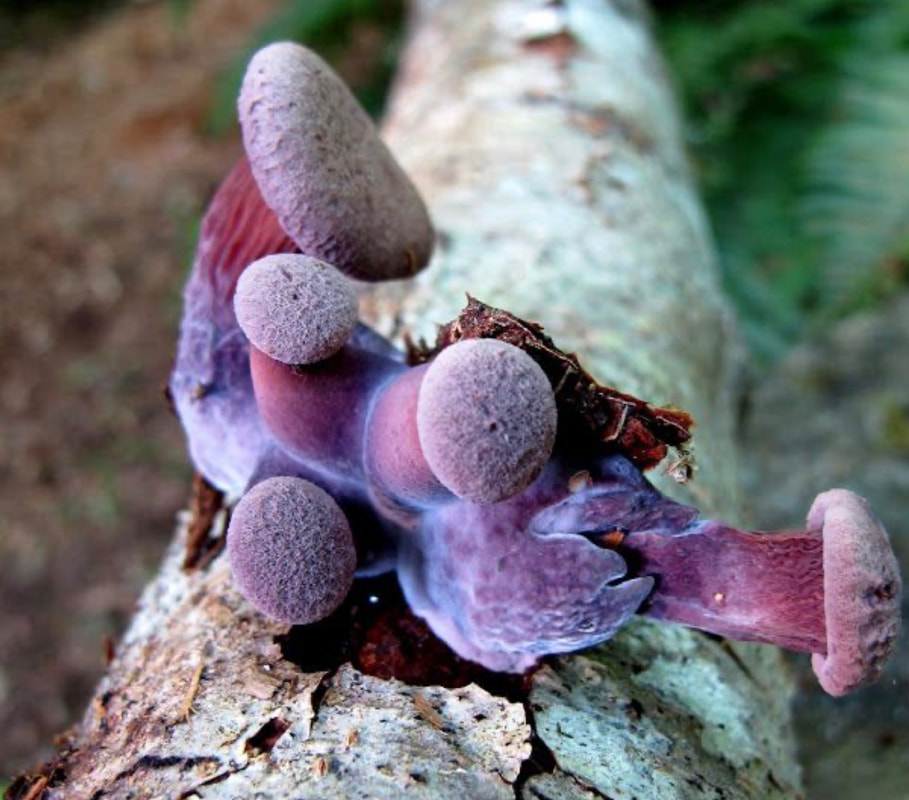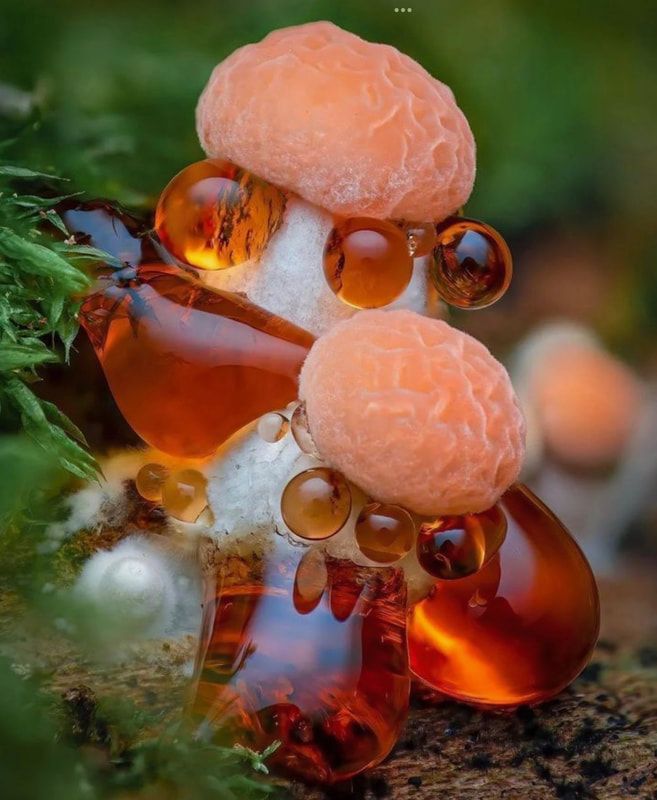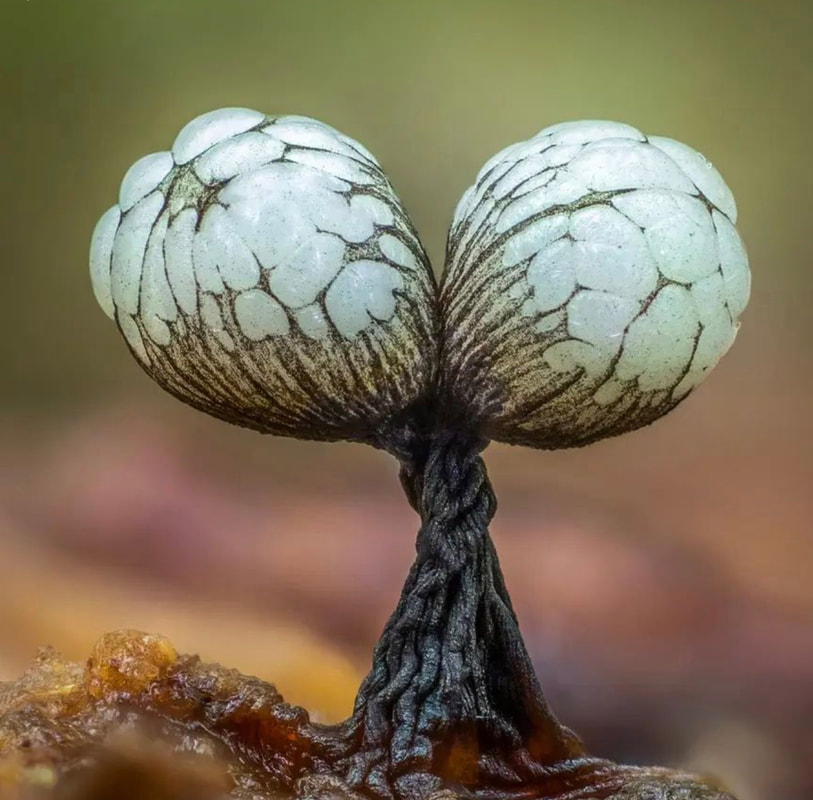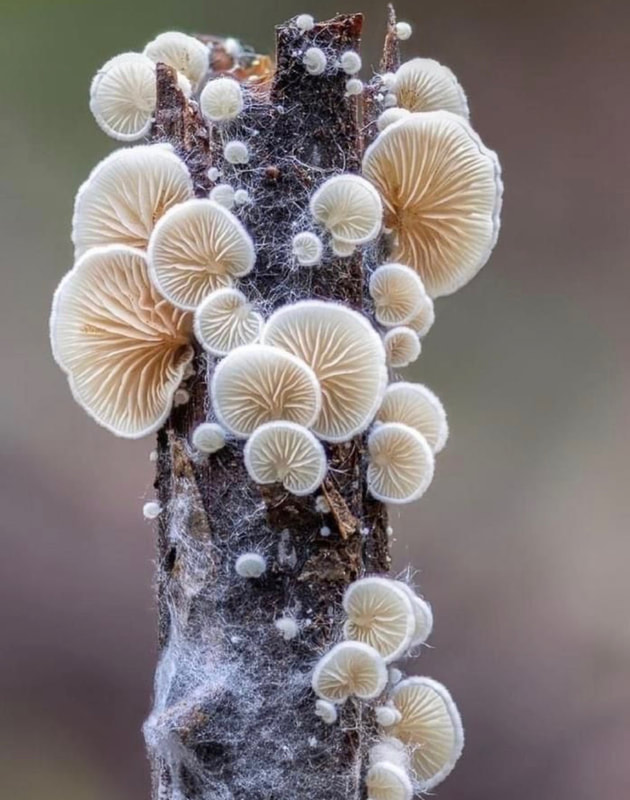|
I have always been fascinated by fungus and mushrooms, lichens and moss. I would be immediately drawn to examine mushrooms discovered on walks, intrigued by how nature created organisms that have such complex, unusual and at times down right bizarre shapes and forms. Initially my interest lay purely in their forms, I loved the gills, the colours, their ability to grow and thrive in the strangest places. I was brought up to be aware that they were also dangerous things and had the potential to make you very ill or even kill you and they shouldn't be touched. I have collected big chunks of bracket fungus and dried them out as decorative items. I have made ceramic mushrooms in the studio and collected fungal art for my home. But up until recently I realised how little I knew about what an incredible organism fungi is, so I have spent quite a bit of time reading, watching and listening to fungal experts and even now I feel like I have barely scratched the surface of what there is to know. Fungi is everywhere, we eat it, wear it, breathe it, it's present inside and outside our bodies, it is found in countless medications including life saving anti-biotics, it can cure us, kill us and has the power change our minds and transform our thinking and provide countless ways to enable us to live more ecologically. Fungi can break down rock, is responsible for the evolution of plant and then animal life on earth, can survive in space, can talk to trees & can zombify insects. As humans we have always believed that any living organism has always needed to possess some kind of brain in order to have the ability to act with intention but fungi is proving that this is not the case, a study of lichen moulds being able to accurately navigate their growth through a maze is causing scientists to re-examine what they know and understand about this. Today there is a strong appetite for developing research into fungi, with the discovery of mycelium (the tangles of hyphae that we don't usually see and which form the biggest part of the fungi, sometimes stretching for miles and miles underground). Mycelium communicates and works symbiotically with trees, and other species of funghi and plants through this complex micorrhizal network, sending signals that warn of danger and that enable them to share nutrition. This signalling has been dubbed the "Wood Wild Web" because of it's similarities to the internet network. The fungi we see in nature is the fruiting body of the mycelium network, it's the end result of a complex web under our feet and it is the means of survival of that species. The fruiting body sends it's spores out in a variety of intriguing and sometimes macabre ways, from exploding puff balls that shoot spores into the air, through to the Ophiocordyceps unilateralis that infest carpenter ants, grows inside them, zombifies them into climbing a tree and then shoots spores out of the ants head and body. There has been a long standing history of fear mongering and concern about the psychotropic effects that some mushrooms have on the mind and human behaviour. Mushrooms have been used in sacred ceremonies within ancient Aztec and Inca tribes for centuries. In the 60's and 70's 'Magic Mushrooms' became very popular and was part of the 'make love not war' ethos of the younger generations of this time. So much so that any mushrooms containing the hallucinogenic chemical Psilocybin were banned here and in the USA and to this day remain illegal in the UK, Psilocybin is a Class A drug, the same category applied to Cocaine and Heroin! There is lots of new and ongoing research happening that has been legally ratified to explore the potential benefits of Psilocybin on people with acute and long standing mental health issues including chronic depression and PTSD so it will be interesting to see if this classification or the use of controlled use of the substance changes in the future. There are many anecdotal testimonies from people across social media talking about the benefits of micro-dosing Psilocybin and lots of groups helping people to safely identify and use native hallucinogenic mushrooms that grow in the UK, so it's clear that the use of mushrooms for more than just recreational purposes isn't going anywhere There is a lot more to write about Fungi and I will continue to update this post as I go along but for me there are three main reasons that I want to use fungal forms as a basis to inspire and influence my work.
Firstly they are such interesting and fascinating things to look at, each is unique and different and their forms and shapes are very inspiring to me. They can evoke both fascination and revulsion in the viewer and I would love to evoke some similar reactions by making work with a surreal, other worldly quality to it. I am also fascinated by the similarities between human behaviour and that of fungi, specifically the symbiotic nature of the micro-risal networks, in some ways human relationships operate in the same way, as families, as friendship groups, as work colleagues, as members of a community and members of society we work together most of the time to help, support and care for each other. I don't think we do it as well as fungi do and we could learn a lot from the way they grow, connect and share and to me that's an important message. Lastly I hope that by making work in this way there is an opportunity to start a conversation about the incredible nature of these organisms, maybe someone will do some research of their own, maybe it could raise awareness about the importance of mushrooms and the need to protect, preserve and fight for the the natural world in which they thrive. Comments are closed.
|
AuthorStella Boothman Archives
February 2024
Categories |




 RSS Feed
RSS Feed
